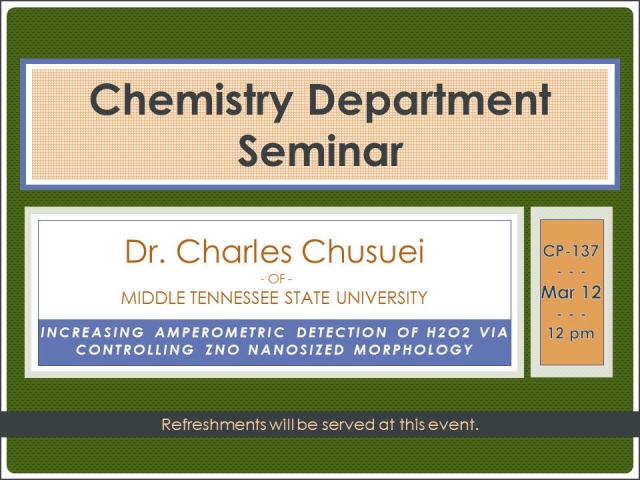Date:
-
Location:
CP-137
Speaker(s) / Presenter(s):
Dr. Charles Chusuei
----------
Please note the updated time and location of this event.
Dr. Charles Chusuei of Middle Tennessee State University will be presenting a seminar titled:
Increasing Amperometric Detection of H2O2 via Controlling ZnO Nanosized Morphology
Abstract: Hydrogen peroxide (H2O2) is an important marker for detecting the onset of food spoilage, oxidative stress and management of cardiovascular disease. The synthesis of zinc oxide (ZnO) nanostructures followed by attachment to multiwalled carbon tubes is shown, resulting in a composite with a unique synergistic effect. Morphology and size of ZnO was controlled using hydrothermal synthesis, varying the hydrothermal treatment temperature, prior to attachment to carboxylic acid functionalized multi-walled carbon nanotubes for sensing applications. A strong dependence of electrocatalytic activity on nanosized ZnO shape was shown. Higher activity for H2O2 reduction was achieved when nanocomposite precursors with a roughly semi-spherical morphology (no needle-like particles present) formed at 90°C. A 2.4-fold increase in cyclic voltammetry current accompanied by decrease in overpotential from the composites made from the nanosized, needle-like-free ZnO shapes was observed as compared to those composites produced from needle-like shaped ZnO. Electrocatalytic activity varied with pH, maximizing at pH 7.4. A stable, linear response for H2O2 concentrations was observed in the 1–20 mM concentration range. The low overpotential observed in the CV demonstrates the composite’s selectivity as it is well-separated from common interfering analytes, such as uric acid.
Faculty Host: Dr. David Atwood

